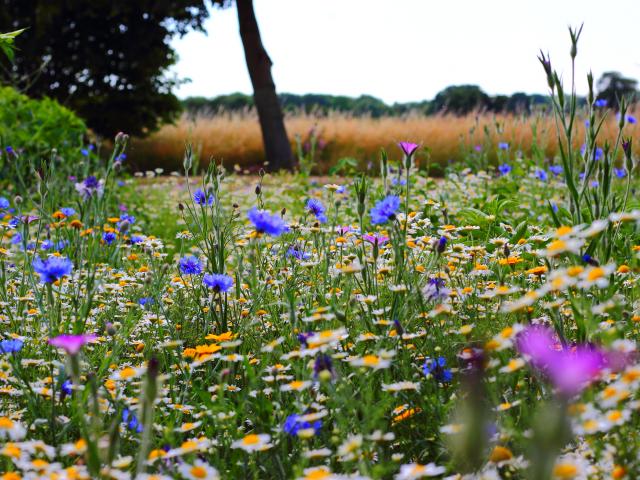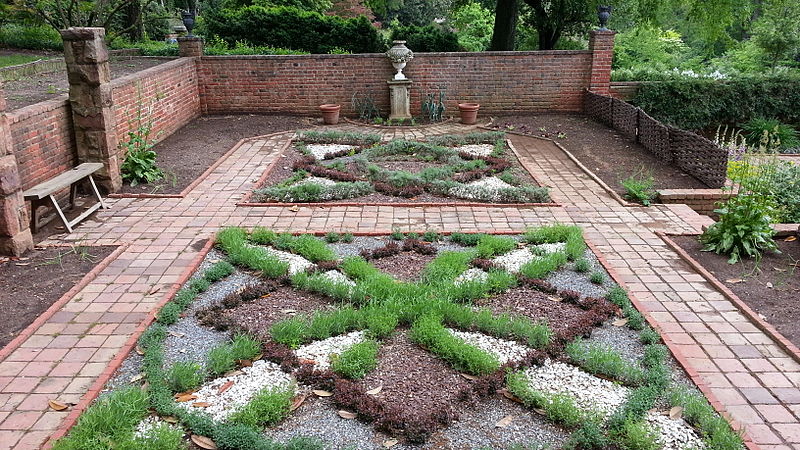Traditionally, the gardening season really kicks off over the Easter bank holiday weekend. Garden centres are currently packed with a wonderful array of plants, ready for the rush of people who are keen to sort out their gardens after all the wet weather.
It is a great time to plant herbs and sow seeds. Why not combine the two in a traditional design? A pretty way to do this is to create a miniature knot garden in a sunny part of the garden.
Knot gardens were a particular feature of the Tudor, Elizabethan and early Stuart periods. Most 16th and 17th century garden books contained advice on plants and designs for knots.
A knot garden was a formal, symmetrical, geometric, entwining design within a square bed. The lines of the pattern were created by planting some form of low, clipped hedge and the spaces in between were filled with colourful plants or coloured gravel, sand or crushed bricks. A popular design was the ‘quartered’ garden of four knots, with each square containing a pattern. The designs were similar to those found on embroidered fabric or like interwoven ribbons. The first representation in British art of an actual knot garden appears in a portrait, painted in 1606. A young Jacobean heiress, Lettice Newdigate, is holding a butterfly, with a knot garden in the background. The design on her bodice reflects the pattern of the garden.
The first representation in British art of an actual knot garden appears in a portrait, painted in 1606. A young Jacobean heiress, Lettice Newdigate, is holding a butterfly, with a knot garden in the background. The design on her bodice reflects the pattern of the garden.
In modern knot gardens the evergreen shrub Box Buxus sempervirens is often used for the hedges. However, originally herbs were used. Lavender was an essential component in Tudor gardens. Its grey leaves, scent and colour were popular for the creation of knots. Other herbs used included hyssop, marjoram and thyme.
You can create your own small knot garden using herb hedges. To fill in the patterns with colour you can choose any butterfly and moth-friendly annual or perennial plants or seeds which you like. One suggestion is to sow wildflower seeds to create a pretty mini-meadow.
Creating the knot garden design

First decide on the size of bed that will fit your garden. You can use an existing flowerbed or create a new area in your lawn. Using four pegs and string, mark out a square. When you are happy with the size, put sand in a bottle and draw along the string lines; you can then remove the string.
Remove all the turf inside the lines and loosen the soil. Wild flowers do not like to grow in nutrient-rich soil so it is a good idea to mix subsoil with top soil to reduce fertility.
Rake the surface and mark out your design within the square using pegs, string and sand as before. If only using a small area it is best to keep the design simple – maybe just divide into four squares or triangles. If a larger area, you could create a Celtic type design.
Herb hedges

Plant herbs along the sand lines, spaced out to allow spreading. The following will all grow to around 50cm high and provide nectar for butterflies and moths through the summer. The herb hedges will need to be trimmed annually to maintain the shape.
• English Lavender ‘Hidcote’ Lavandula angustifolia ‘Hidcote’
A bushy dwarf evergreen shrub with small deep violet-purple flowers in summer.
• Wild Marjoram Origanum vulgare
Dark purple buds at the top of the stem open to show pale mauve flowers through summer and into early autumn.
• Rosemary Rosmarinus officinalis ‘Prostratus’
An evergreen shrub with blue flowers in spring and summer.
• Common Thyme Thymus vulgaris
A bushy dwarf shrub with small, white or pink flowers in early summer
Colourful filler plants

Within the shapes you could try sowing a selection or mixture of the following wildflowers, which are valuable to butterflies and moths as nectar plants and/or foodplants for caterpillars.
• Red Clover Trifolium pratense
• Salad Burnet Sanguisorba minor
• Wild Carrot Daucus carota
• Ox-eye Daisy Leucanthemum vulgare
• Yarrow Achillea millefolium
• Lady’s Bedstraw Galium verum
• Common Knapweed Centaurea nigra
• Meadow Buttercup Ranunculus acris
• Common Bird’s-foot-trefoil Lotus corniculatus
• Bladder Campion Silene vulgaris
Many seeds will flower six to eight weeks after sowing, so you should have a lovely display in the summer attracting butterflies such as the Gatekeeper, Common Blue, Small Tortoiseshell and Large, Small and Green-veined Whites.
Happy Gardening!
The Secret Gardener
The images are courtesy of the Garden Museum in London.
Their Fashion and Gardens exhibition will run until 27 April 2014 and will be followed by
A History of Gardening in 100 Objects with Alan Titchmarsh from 19 May to 31 August.
www.gardenmuseum.org.uk/page/exhibitions-3


